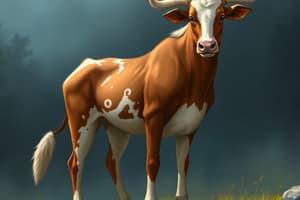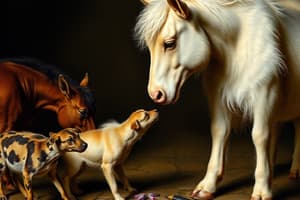Podcast
Questions and Answers
What is domestication syndrome?
What is domestication syndrome?
- The conditioned behavioral modification of an individual animal
- The genetic modification of a bred lineage
- The suite of phenotypic traits arising during domestication that distinguish crops from their wild ancestors (correct)
- The process of taming wild animals for human use
What is the difference between improvement traits and domestication traits?
What is the difference between improvement traits and domestication traits?
- Improvement traits and domestication traits are the same thing
- Improvement traits are fixed in all domesticates, while domestication traits are present only in a proportion of domesticates and are selected during the domestication process
- Improvement traits and domestication traits are not related to domestication
- Improvement traits are present only in a proportion of domesticates and are selected during the domestication process, while domestication traits are fixed in all domesticates (correct)
What is the difference between taming and domestication?
What is the difference between taming and domestication?
- Taming and domestication are the same thing
- Taming and domestication are not related to each other
- Taming is the conditioned behavioral modification of an individual animal, while domestication is the permanent genetic modification of a bred lineage (correct)
- Taming is the permanent genetic modification of a bred lineage, while domestication is the conditioned behavioral modification of an individual animal
What is the Island Model of Genomic Selection?
What is the Island Model of Genomic Selection?
What is the difference between cultigens and livestock?
What is the difference between cultigens and livestock?
What is the difference between directed, commensal, and prey pathways in domestication?
What is the difference between directed, commensal, and prey pathways in domestication?
What is the impact of plant domestication on the microbiome of plants?
What is the impact of plant domestication on the microbiome of plants?
What is the difference between cereal crops and annuals with large seeds or fruits?
What is the difference between cereal crops and annuals with large seeds or fruits?
What is the impact of domestication on animal size and genetic variability?
What is the impact of domestication on animal size and genetic variability?
Flashcards are hidden until you start studying
Study Notes
Selective Breeding of Plants and Animals for Human Use
-
Domestication is a long-term relationship between humans and organisms, where humans assume control over the reproduction and care of the organisms to secure a predictable supply of resources.
-
Charles Darwin recognized conscious selective breeding and unconscious selection of desirable traits, leading to genetic differences between domestic and wild populations.
-
Improvement traits are present only in a proportion of domesticates and are selected during the domestication process, while domestication traits are fixed in all domesticates.
-
The dog was the first domesticated species, followed by other livestock and crops, and the domestication of animals and plants was triggered by environmental changes.
-
Domestication syndrome refers to the suite of phenotypic traits arising during domestication that distinguish crops from their wild ancestors.
-
Domesticated plants are called cultigens, and animals domesticated for home companionship are called pets, while those domesticated for food or work are known as livestock.
-
Domestication is a mutualistic relationship in which both partners gain benefits, and this biological mutualism is not restricted to humans with domestic crops and livestock.
-
Taming is the conditioned behavioral modification of an individual animal, while domestication is the permanent genetic modification of a bred lineage.
-
Domestication pathways for animals include directed, commensal, and prey pathways, and bidirectional gene flow between wild and domestic stocks was common.
-
Domesticated birds include poultry such as chicken and turkey, and cagebirds such as songbirds and parrots.
-
Invertebrates such as silkworms and honey bees have been domesticated for commercial use, while others are used for food or other products.
-
The initial domestication of animals impacted most on the genes that controlled their behavior, while the initial domestication of plants impacted most on the genes that controlled their morphology and physiology.
-
The earliest human attempts at plant domestication occurred in the Middle East, and agriculture developed in at least 11 different centers around the world.Domestication of Plants and Animals
-
Bottle gourd plant was domesticated 10,000 years ago and reached the Americas from Asia by 8,000 years ago due to migration of people.
-
Cereal crops were first domesticated 11,000 years ago in the Middle East, and the first domesticated crops were annuals with large seeds or fruits such as peas and wheat.
-
Continued domestication led to the domestication of perennials and small trees such as apples and olives, and some plants such as macadamia nut and pecan were domesticated recently.
-
Different species were domesticated in different parts of the world, such as squash, maize, beans, and manioc in the Americas and millet, rice, and soy in East Asia.
-
Domesticated plants may differ from their wild relatives in many ways, including size, shape, color, and taste.
-
The microbiome of plants has been shown to be affected by plant domestication and breeding, and plant lineage has shaped plant endophytes in similar patterns as plant genes.
-
Drought resistance in major crop plants has become a clear priority due to climate change, and one method is to identify the genetic basis of drought resistance in naturally drought-resistant plants.
-
Crop plants’ uptake and utilization of soil potassium, an essential element for crop plants yield and overall quality, can be improved by optimizing plant root architecture and root potassium uptake activity.
-
The researchers suggest an "Island Model of Genomic Selection" to combat the issue of limited diversity in cereal crop plants.
-
Work has been focusing on improving domestic crops through the use of crop wild relatives by hybridizing wild plants with crop plants to form perennial crops from annuals and increase yield, growth rate, and resistance to outside pressures like disease and drought.
-
Domestication of animals often results in smaller size, diminished horns, weak muscle ridges, and less genetic variability, and domesticated animals often have poor joint definition, late fusion of the limb bone epiphyses with the diaphyses, hair changes, greater fat accumulation, smaller brains, simplified behavior patterns, extended immaturity, and more pathology.
-
Domestication has resulted in zoonotic diseases, and the advent of domestication resulted in denser human populations which provided ripe conditions for pathogens to reproduce, mutate, spread, and eventually find a new host in humans.
-
Domestication has led to the destruction, enslavement, or assimilation of other groups of early people who did not make such a transition.
-
Domestication disrupted the balance of nature and laid the foundation for social hierarchy as property and power emerged.
-
Domestication of animals can be understood as the domestication of humanity itself in turn.
-
Domestication of animals resulted in the corruption of human ethics and helped pave the way for societies steeped in "conquest, extermination, displacement, repression, coerced and enslaved servitude, gender subordination and sexual exploitation, and hunger."
-
Humans have had a major impact on global genetic diversity as well as extinction rates, including a contribution to megafaunal extinctions.
Studying That Suits You
Use AI to generate personalized quizzes and flashcards to suit your learning preferences.




